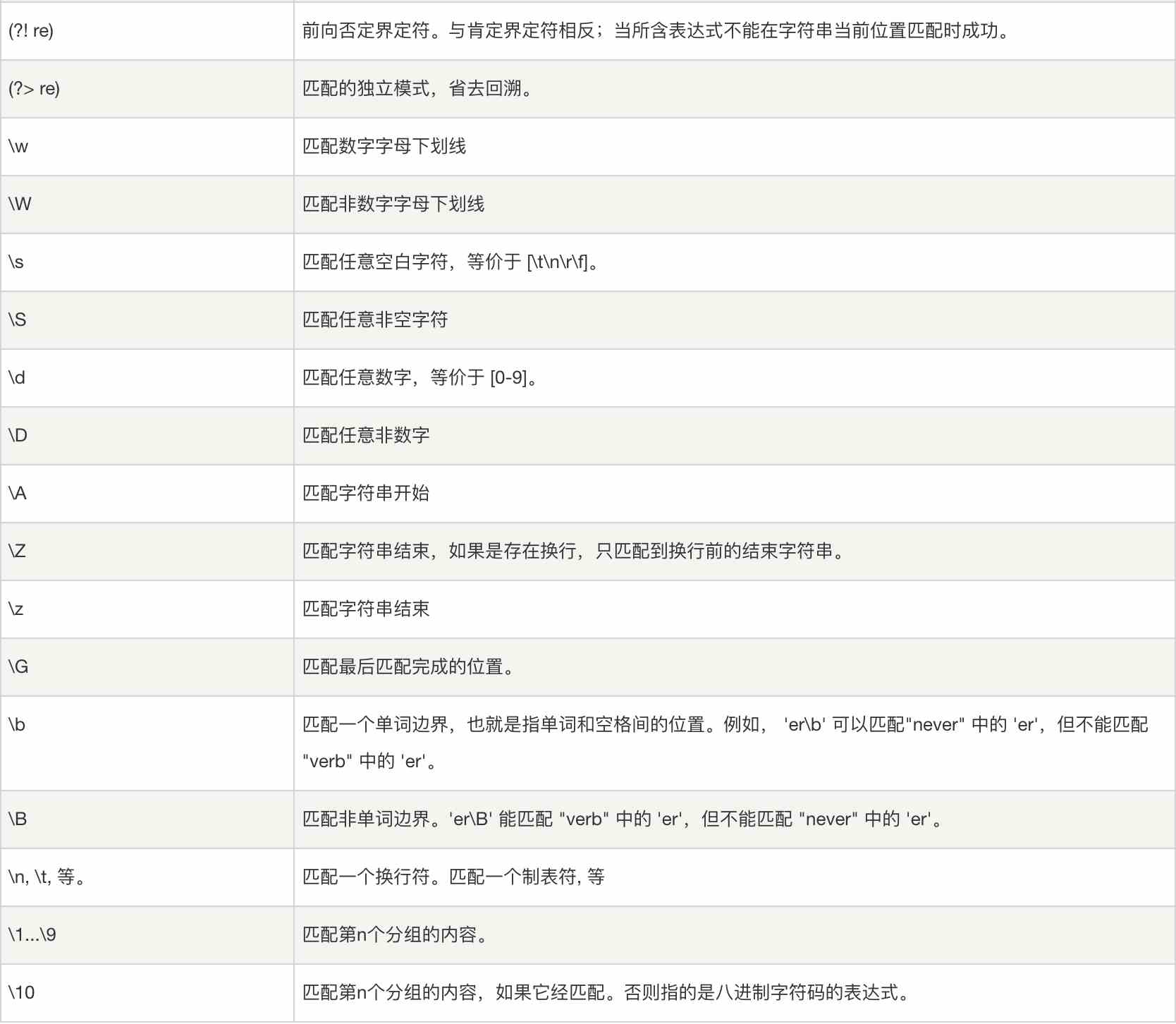Python正则表达式 一篇文章带你入门Python正则表达式
古杜且偲 人气:0想了解一篇文章带你入门Python正则表达式的相关内容吗,古杜且偲在本文为您仔细讲解Python正则表达式的相关知识和一些Code实例,欢迎阅读和指正,我们先划重点:Python表达式,Python正则表达式,下面大家一起来学习吧。
Python3 正则表达式
正则表达式是一个特殊的字符序列,它能帮助你方便的检查一个字符串是否与某种模式匹配。本文主要阐述re包中的主要函数。
在阐述re包中的函数之前,我们首先看议案正则表达式的模式,即使用特殊的语法来表示一个正则表达式。


1.match函数
- re.match 尝试从字符串的起始位置匹配一个模式,如果不是起始位置匹配成功的话,match()就返回none。
- 函数用法:re.match(pattern, string, flags=0)
- pattern: 所要匹配的正则表达式string: 要匹配的字符串flags: 标志位,用于控制正则表达式的匹配方式,如:是否区分大小写,多行匹配等等。
- re.I 忽略大小写
- re.L 表示特殊字符集 \w, \W, \b, \B, \s, \S 依赖于当前环境
- re.M 多行模式re.S 即为' . ‘并且包括换行符在内的任意字符(' . '不包括换行符)
- re.U 表示特殊字符集 \w, \W, \b, \B, \d, \D, \s, \S 依赖于 Unicode 字符属性数据库
- re.X 为了增加可读性,忽略空格和' # '后面的注释
匹配对象方法:
- group(num=0): 匹配的整个表达式的字符串,group() 可以一次输入多个组号,在这种情况下它将返回一个包含那些组所对应值的元组。
- groups(): 返回一个包含所有小组字符串的元组,从 1 到 所含的小组号。
import re
print(re.match("xixi", "xixi_haha_heihei").group())
xixi
line = 'Cats are smarter than dogs' b = re.match(r'(.*) are (.*?) .*', line, re.M|re.I) print(b.group()) # 返回所有 print(b.group(1)) # 返回第一组,即(.*)对应的 print(b.group(2)) # 返回第二组,即(.*?)对应的
Cats are smarter than dogs Cats smarter
2.search函数
re.search 扫描整个字符串并返回第一个成功的匹配。
函数用法:re.search(pattern, string, flags=0)
print(re.match('heihei', 'xixi_haha_heihei'))
print(re.search('heihei', 'xixi_haha_heihei').group())
None heihei
line = 'Cats are smarter than dogs' b = re.search(r'(.*) are (.*?) .*', line, re.M|re.I) print(b.group()) # 返回所有 print(b.group(1)) # 返回第一组,即(.*)对应的 print(b.group(2)) # 返回第二组,即(.*?)对应的
Cats are smarter than dogs Cats smarter
search和match的区别
match只匹配字符串的开始,如果字符串开始不符合正则表达式,则匹配失败,函数返回None;而search匹配整个字符串,直到找到一个匹配。
3. sub函数
re提供了re.sub来替换字符串中的匹配项。
函数用法:re.sub(pattern, repl, string, count=0, flags=0)
- pattern : 正则中的模式字符串。
- repl : 替换的字符串,也可为一个函数。
- string : 要被查找替换的原始字符串。
- count : 模式匹配后替换的最大次数,默认 0 表示替换所有的匹配。
- flags : 编译时用的匹配模式,数字形式。
phone = '133-3333-3333 # this is a phone number'
num = re.sub(r'#.*$', '', phone)
print('phone num', num)
# 移除注释,找到以#开头的。
num = re.sub(r'\D', '', phone)
print('phone num', num)
# 移除非数字内容
phone num 133-3333-3333 phone num 13333333333
repl是函数的情况
def double(matched):
value = int(matched.group('value'))
return str(value * 2)
s = 'A233Sfd34'
print(re.sub('(?P<value>\d+)', double, s))
A466Sfd68
4.compile函数
compile 函数用于编译正则表达式,生成一个正则表达式( Pattern )对象,供 match() 和 search() 这两个函数使用。
函数使用:re.compile(pattern, flags)
pattern = re.compile(r'/d+')
m = pattern.match('ones123412')
print(m)
None
5.findall
在字符串中找到正则表达式所匹配的所有子串,并返回一个列表,如果没有找到匹配的,则返回空列表。
注意:match和search是匹配一次,但是findall是匹配所有。
函数使用:findall(string, pos, endpos)
- string 待匹配的字符串。
- pos 可选参数,指定字符串的起始位置,默认为 0。
- endpos 可选参数,指定字符串的结束位置,默认为字符串的长度。
pattern = re.compile(r'\d+')
result1 = pattern.findall('xixixix 123 heihiehei 456')
result2 = pattern.findall('xixixix 123 heihiehei 456', 0, 15)
print(result1)
print(result2)
['123', '456'] ['123']
6.finditer
和 findall 类似,在字符串中找到正则表达式所匹配的所有子串,并把它们作为一个迭代器返回。
ittt = re.finditer(r'\d+', '12dsfasdf123asdf534')
for ttt in ittt:
print(ttt.group())
12 123 534
7.split
split 方法按照能够匹配的子串将字符串分割后返回列表。
函数使用:
re.split(pattern, string, maxsplit=0, flags=0)
- pattern: 匹配的正则表达式
- string: 要匹配的字符串。
- maxsplit: 分隔次数,maxsplit=1 分隔一次,默认为 0,不限制次数。
- flags: 标志位,用于控制正则表达式的匹配方式,
print(re.split('\W+', 'xxixix, xixixi, hehiehei'))
print(re.split('(\W+)', ' xxixix, xixixi, hehiehei'))
['xxixix', 'xixixi', 'hehiehei'] ['', ' ', 'xxixix', ', ', 'xixixi', ', ', 'hehiehei']
总结
本篇文章就到这里了,希望能够给你带来帮助,也希望您能够多多关注的更多内容!
加载全部内容